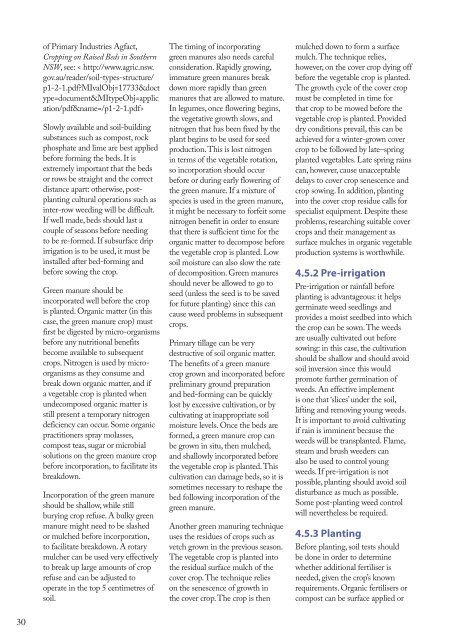4. Organic vegetable production
4. Organic vegetable production
4. Organic vegetable production
Create successful ePaper yourself
Turn your PDF publications into a flip-book with our unique Google optimized e-Paper software.
of Primary Industries Agfact,<br />
Cropping on Raised Beds in Southern<br />
NSW, see: < http://www.agric.nsw.<br />
gov.au/reader/soil-types-structure/<br />
p1-2-1.pdf?MIvalObj=17733&doct<br />
ype=document&MItypeObj=applic<br />
ation/pdf&name=/p1-2-1.pdf><br />
Slowly available and soil-building<br />
substances such as compost, rock<br />
phosphate and lime are best applied<br />
before forming the beds. It is<br />
extremely important that the beds<br />
or rows be straight and the correct<br />
distance apart: otherwise, postplanting<br />
cultural operations such as<br />
inter-row weeding will be difficult.<br />
If well made, beds should last a<br />
couple of seasons before needing<br />
to be re-formed. If subsurface drip<br />
irrigation is to be used, it must be<br />
installed after bed-forming and<br />
before sowing the crop.<br />
Green manure should be<br />
incorporated well before the crop<br />
is planted. <strong>Organic</strong> matter (in this<br />
case, the green manure crop) must<br />
first be digested by micro-organisms<br />
before any nutritional benefits<br />
become available to subsequent<br />
crops. Nitrogen is used by microorganisms<br />
as they consume and<br />
break down organic matter, and if<br />
a <strong>vegetable</strong> crop is planted when<br />
undecomposed organic matter is<br />
still present a temporary nitrogen<br />
deficiency can occur. Some organic<br />
practitioners spray molasses,<br />
compost teas, sugar or microbial<br />
solutions on the green manure crop<br />
before incorporation, to facilitate its<br />
breakdown.<br />
Incorporation of the green manure<br />
should be shallow, while still<br />
burying crop refuse. A bulky green<br />
manure might need to be slashed<br />
or mulched before incorporation,<br />
to facilitate breakdown. A rotary<br />
mulcher can be used very effectively<br />
to break up large amounts of crop<br />
refuse and can be adjusted to<br />
operate in the top 5 centimetres of<br />
soil.<br />
The timing of incorporating<br />
green manures also needs careful<br />
consideration. Rapidly growing,<br />
immature green manures break<br />
down more rapidly than green<br />
manures that are allowed to mature.<br />
In legumes, once flowering begins,<br />
the vegetative growth slows, and<br />
nitrogen that has been fixed by the<br />
plant begins to be used for seed<br />
<strong>production</strong>. This is lost nitrogen<br />
in terms of the <strong>vegetable</strong> rotation,<br />
so incorporation should occur<br />
before or during early flowering of<br />
the green manure. If a mixture of<br />
species is used in the green manure,<br />
it might be necessary to forfeit some<br />
nitrogen benefit in order to ensure<br />
that there is sufficient time for the<br />
organic matter to decompose before<br />
the <strong>vegetable</strong> crop is planted. Low<br />
soil moisture can also slow the rate<br />
of decomposition. Green manures<br />
should never be allowed to go to<br />
seed (unless the seed is to be saved<br />
for future planting) since this can<br />
cause weed problems in subsequent<br />
crops.<br />
Primary tillage can be very<br />
destructive of soil organic matter.<br />
The benefits of a green manure<br />
crop grown and incorporated before<br />
preliminary ground preparation<br />
and bed-forming can be quickly<br />
lost by excessive cultivation, or by<br />
cultivating at inappropriate soil<br />
moisture levels. Once the beds are<br />
formed, a green manure crop can<br />
be grown in situ, then mulched,<br />
and shallowly incorporated before<br />
the <strong>vegetable</strong> crop is planted. This<br />
cultivation can damage beds, so it is<br />
sometimes necessary to reshape the<br />
bed following incorporation of the<br />
green manure.<br />
Another green manuring technique<br />
uses the residues of crops such as<br />
vetch grown in the previous season.<br />
The <strong>vegetable</strong> crop is planted into<br />
the residual surface mulch of the<br />
cover crop. The technique relies<br />
on the senescence of growth in<br />
the cover crop. The crop is then<br />
mulched down to form a surface<br />
mulch. The technique relies,<br />
however, on the cover crop dying off<br />
before the <strong>vegetable</strong> crop is planted.<br />
The growth cycle of the cover crop<br />
must be completed in time for<br />
that crop to be mowed before the<br />
<strong>vegetable</strong> crop is planted. Provided<br />
dry conditions prevail, this can be<br />
achieved for a winter-grown cover<br />
crop to be followed by late–spring<br />
planted <strong>vegetable</strong>s. Late spring rains<br />
can, however, cause unacceptable<br />
delays to cover crop senescence and<br />
crop sowing. In addition, planting<br />
into the cover crop residue calls for<br />
specialist equipment. Despite these<br />
problems, researching suitable cover<br />
crops and their management as<br />
surface mulches in organic <strong>vegetable</strong><br />
<strong>production</strong> systems is worthwhile.<br />
<strong>4.</strong>5.2 Pre-irrigation<br />
Pre-irrigation or rainfall before<br />
planting is advantageous: it helps<br />
germinate weed seedlings and<br />
provides a moist seedbed into which<br />
the crop can be sown. The weeds<br />
are usually cultivated out before<br />
sowing: in this case, the cultivation<br />
should be shallow and should avoid<br />
soil inversion since this would<br />
promote further germination of<br />
weeds. An effective implement<br />
is one that ‘slices’ under the soil,<br />
lifting and removing young weeds.<br />
It is important to avoid cultivating<br />
if rain is imminent because the<br />
weeds will be transplanted. Flame,<br />
steam and brush weeders can<br />
also be used to control young<br />
weeds. If pre-irrigation is not<br />
possible, planting should avoid soil<br />
disturbance as much as possible.<br />
Some post-planting weed control<br />
will nevertheless be required.<br />
<strong>4.</strong>5.3 Planting<br />
Before planting, soil tests should<br />
be done in order to determine<br />
whether additional fertiliser is<br />
needed, given the crop’s known<br />
requirements. <strong>Organic</strong> fertilisers or<br />
compost can be surface applied or<br />
30

















